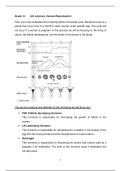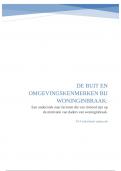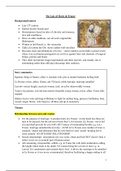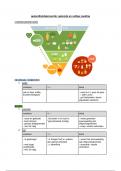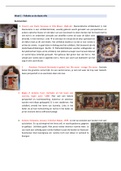Cognitive Psychology Summary
Cognitive
course
Psychology
assignment Preparation
progress done
PROBLEM 1: ATTENTION
Selective Attention
💡 Selective attention refers to the processes that allow you to focus on a
particular stimulus for further processing while simultaneously suppressing
irrelevant information
Cocktail party phenomenon (Colin Cherry) = a process in which the auditory
attention is focused on a specific stimulus while the other stimuli are filtered out
Shadowing (Colin Cherry) = a process in which you listen to two different
messages but only focus on one
Colin Cherry Experiment:
A separate message was presented in each ear → Dichotic presentation
There had to follow one message and ignore the other → Majority succeeded, but
required lots of concentration
Cognitive Psychology Summary 1
, The participants were able to notice sensory changes in the attended message but
not in the other one
Researchers say that those who switched to the unattended message when hearing
their name had a limited working-memory capacity
Three Factors That Improve Selective Listening:
1. Distinctive sensory characteristics of the target’s speech (e.g., high/low pitch,
pacing)
2. Sound intensity (loudness)
3. Location of the sound source
Spatial cues are less important than factors like harmony and rhythm
Theories of Selective Attention
These belongs to group of filter and bottleneck theories
A filter blocks parts of information
A bottleneck slows down the flow of information
The Models Differ in Two Ways:
1. The absence or presence of a filter
2. If they have a filter, when does this occur in the process
Broadbent’s Model:
One of the earliest theories
We filter information immediately after it has been perceived at the sensory level
Multiple channels of sensory input reach a selective filter → only one channel can
go on to the perceptual process (the rest does not reach perception)
Cognitive Psychology Summary 2
, Moray’s Selective Filter Model:
Messages of great personal importance can break the filter of selective attention
The selective filter blocks out most information (Broadbent) but some personally
important messages can burst through the filtering mechanism
Treisman’s Attenuation Model:
He conducted “shadowing” experiments → findings suggest that some of the
ignored information is still analyzed
Instead of blocking stimuli the filter only reduces the strength of the other stimuli
(bottleneck theory)
So, when the unattended stimuli reaches us we analyze them at a low level on the
basis of physical characteristics (e.g., pitch)
In the next step, we analyze the meaning of the stimuli and their relevance to us →
even irrelevant information can enter our consciousness and influence our
subsequent actions
Cognitive Psychology Summary 3
, Deutsch’s Late-Filter Model:
The location of the filter is even later
The stimuli are filtered out after they have been analyzed for both their physical
properties and their meaning
This allows people to recognize information entering the unattended ear (e.g.,
hearing own name)
A Synthesis of Early-Filter and Late-Filter Models:
There are two processes that are governing attention
1. Pre-attentive processes: These processes are automatic and happen rapid and in
parallel. They can be used to notice only physical sensory characteristics of the un-
attentive message
Cognitive Psychology Summary 4
Cognitive
course
Psychology
assignment Preparation
progress done
PROBLEM 1: ATTENTION
Selective Attention
💡 Selective attention refers to the processes that allow you to focus on a
particular stimulus for further processing while simultaneously suppressing
irrelevant information
Cocktail party phenomenon (Colin Cherry) = a process in which the auditory
attention is focused on a specific stimulus while the other stimuli are filtered out
Shadowing (Colin Cherry) = a process in which you listen to two different
messages but only focus on one
Colin Cherry Experiment:
A separate message was presented in each ear → Dichotic presentation
There had to follow one message and ignore the other → Majority succeeded, but
required lots of concentration
Cognitive Psychology Summary 1
, The participants were able to notice sensory changes in the attended message but
not in the other one
Researchers say that those who switched to the unattended message when hearing
their name had a limited working-memory capacity
Three Factors That Improve Selective Listening:
1. Distinctive sensory characteristics of the target’s speech (e.g., high/low pitch,
pacing)
2. Sound intensity (loudness)
3. Location of the sound source
Spatial cues are less important than factors like harmony and rhythm
Theories of Selective Attention
These belongs to group of filter and bottleneck theories
A filter blocks parts of information
A bottleneck slows down the flow of information
The Models Differ in Two Ways:
1. The absence or presence of a filter
2. If they have a filter, when does this occur in the process
Broadbent’s Model:
One of the earliest theories
We filter information immediately after it has been perceived at the sensory level
Multiple channels of sensory input reach a selective filter → only one channel can
go on to the perceptual process (the rest does not reach perception)
Cognitive Psychology Summary 2
, Moray’s Selective Filter Model:
Messages of great personal importance can break the filter of selective attention
The selective filter blocks out most information (Broadbent) but some personally
important messages can burst through the filtering mechanism
Treisman’s Attenuation Model:
He conducted “shadowing” experiments → findings suggest that some of the
ignored information is still analyzed
Instead of blocking stimuli the filter only reduces the strength of the other stimuli
(bottleneck theory)
So, when the unattended stimuli reaches us we analyze them at a low level on the
basis of physical characteristics (e.g., pitch)
In the next step, we analyze the meaning of the stimuli and their relevance to us →
even irrelevant information can enter our consciousness and influence our
subsequent actions
Cognitive Psychology Summary 3
, Deutsch’s Late-Filter Model:
The location of the filter is even later
The stimuli are filtered out after they have been analyzed for both their physical
properties and their meaning
This allows people to recognize information entering the unattended ear (e.g.,
hearing own name)
A Synthesis of Early-Filter and Late-Filter Models:
There are two processes that are governing attention
1. Pre-attentive processes: These processes are automatic and happen rapid and in
parallel. They can be used to notice only physical sensory characteristics of the un-
attentive message
Cognitive Psychology Summary 4

